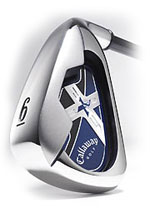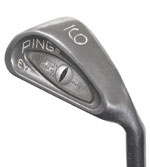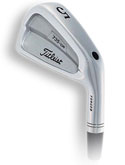Golf club irons are at the heart of every golf set. You may “drive for show and putt for dough” but without an iron in between you can really play golf very successfully. On just about every hole the iron shot is how you get to the green.
What makes an iron easy to hit?
So what is it about the design of a golf club iron that makes it work well and consistently for any given golfer. The variations in design of a any clubhead are about basically one thing—moving weight around. Where the weight is located effects the center of gravity of the club and is one factor that determines the “moment of inertia” or MOI of a clubhead. A high moment of inertia creates a more stable, solid hit and a clubhead that is less prone to twisting.

Moving weight to the correct places also can make the sweet spot larger. A larger sweet spot means a larger hitting area which translates to more solid contact and greater distance.
So how do golf club designers move the weight and expand the sweet spot? It’s not as easy as it sounds. In order to maintain a proper swing weight (the percieved heaviness of the club) the overall weight of the head must remain about the same. Typically mass from behind the face must me taken out and moved to the perimeters of the club. This process creates an empty cavity behind the face and led to the name “cavity back” iron.
The Ping Factor

One of the the first to do this was Ping back in the early 80s with their Ping Eye irons. Karsten Solheim, the founder of Ping, through experiments with putters, discovered that he could add more MOI by moving weight to the perimeter of the club. His strange looking iron design soon caught on and within a couple of years was the best selling iron on the market. His Ping Eye 2 remains one of the leading clubs of all time.
Perimeter weighting
Putting extra weight out at the heel, sole, topline and the toe is the major factor in creating a larger MOI and more forgiveness. This is called perimeter weighting. Since the Eye 2 every major club manufacturer has introduced perimeter weighted clubs, each claiming to improve on the original concept. Clearly the design has been a game-improver for many high handicap golfers and these days fewer and fewer golfers use the harder to hit “blade” style clubs.
It certainly can be said that the cavity back design has been been put through its paces with variations galore. The category of easy to hit irons has been called Game Improvement clubs. Golf Digest in its latest Hot List used the term Super Game Improvement to descibe those clubs that offer extreme forgiveness. So what are the other features that create this forgiveness?
Offset

Another factor that effects club performance is the offset of the face. By moving the head a little backward from the shaft the clubhead will strike the ball at more optimum point. An offset clubface gives the golfer a little more time to square the clubhead thus reducing slices.
Most modern Game Improvement clubs feature offset to varying degrees. Typically the better the player the less offset required. Some say that offset clubs make the ball a little harder to “work”. Work means moving the ball left to right or right to left depending on shot requirements. Blade style clubs typically offer less or no offset and are often preferred by better golfers.
Some clubs offer “progessive” offset. This means the longer clubs have progressivly more offset while wedges having little or none.
Thick Topline
The edge at the top of the club is called the topline. It is part of the perimeter weighting feature described earlier. It’s main benefit is that balls hit high on the club face will still be solid and maintain their distance. Some golfers feel that an iron with a thick topline just looks easy to hit…to the average golfer at least. Some better players feel diffently.
Wide Sole
A wide sole serves two purposes. The added weight creates a lower center of gravity which promotes a higher shot. A wider sole also has less of a tendency to dig into the turf. This means fewer fat shots. A wide sole also has a better chance of getting through rough and the sand.
What About Blades?

Blade irons are simple, clean and to the point. No fancy weighting involved. Blade designs have been around for at least 100 years and many of the best players prefer them.
In a blade the main COG movement involves adding some additional weight low behind the face. These are typically called “muscle back” irons. Blades are still favored by professionals and advanced players due to their feel and traditional look. However fewer and fewer pros are playing blades.
Originally irons were hand forged, often by a blacksmith. Those club designs were very simple and did literally look like a blade. As the forging process evolved the iron became a bit more sophisticated. Through the 40s to the 70s forged blade irons were the standard.
Until recently, forged clubs and blade style clubs were considered synonymous. Today you can find cavity back designs that are forged. Due to the more expensive forging process these clubs may cost a little more than cast cavity backs, but their quality does shine thru—if not their forgiveness.
How Irons Have Changed
One final point about irons. In the last 10 or 15 years most manufactures have changed the length and loft of just about all golf clubs. It’s safe to say, what used to be a 7 iron is now a 6 and a 6 is now a 5, etc. What does this mean. The ball does go further, BUT, it probably won’t go any straighter. Irons are for the most part the accuracy clubs, and are not necessarily about more distance. Keep this in mind when configuring your set.
In fact, Tiger Woods plays with irons that have the same loft of the irons of the 70s. He says his pitching wedge is about 51 degrees. In fact here’s his quote.
“Well, my pitching wedge is like 51 degrees. My 9 iron is like 45, and that’s like most people’s gap wedges. A lot of the guys’ pitching wedge is like my 9 irons, so I play with very weak lofts, but they have worked so far. I haven’t changed my iron lofts since I was 14 years old.”
Tiger Woods
Anyway it’s something to be aware of.
So what are the hot irons out there at the moment. According to Golf Digest and it’s Hot List 2009, they have a separate recommendation for each category of iron—super game improvement, game improvement, and players irons.
Actually all of the recommended clubs in the Hot List are excellent clubs. Remember, finding the right ones for you involves understanding your game, getting fit properly, and playing them to make sure they feel right. If you do that you have an excellent chance of finding clubs that will improve your game and help you have more fun on the course. Click on the pictures and links above to learn more and find the best deals on these beauties.

